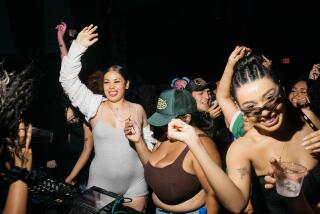Las Vegas-like glitz trumps Brazilian authenticity
- Share via
Who knew that when the universe was created it was tricked out in gold lame? At least that’s what Bale Folclorico da Bahia would have us believe, as evidenced by its opening number in the glitzy program “Bahia of All Colors,” presented at the Alex Theatre on Saturday night.
Founded in 1988 by choreographer Walson Botelho and Ninho Reis, the Salvador-based troupe, under the artistic direction of Jose Carlos Arandiba, opts for Vegas-like theatricality over authenticity in showcasing Brazil’s rich cultural traditions.
The 90-minute intermissionless concert was a blur of feverish dances, with African, Portuguese and indigenous-influenced works virtually interchangeable. Adding to the artistic haze was the deafening percussion music and over-amped singing of Dora Santana and Miralva Cuoto (swathed in turbans and caftans, they were, incredibly, shod in gold platform pumps).
Topping things off, the Alex management failed to provide programs for the audience. After some wrangling, however, this reviewer received a makeshift list of numbers. Included was “Danca de Origem” (Origin Dance), the above-mentioned opus depicting the world’s beginnings as interpreted through Candomble, the African religion brought to Brazil by slaves. Choreographed by Augusto Omolu, it featured some noble arabesques and postmodern lunging but quickly descended into stereotypical shimmying and mad whirling.
But the 16 indefatigable dancers did look sleek, with the martial arts pieces faring best: Botelho’s “Maculele,” a dance celebrating the harvest that also served as training in self-defense for slaves, was a stick-and-knife-wielding stomp fest with sparks flying, literally. In “Capoeira,” Botelho and Arandiba had men squaring off with high kicks and twisting cartwheels, their gymnastics benefiting from razor-sharp timing.
Providing an oddball diversion was Fabio Santos, the Jimi Hendrix of the berimbau (a musical bow with gourd resonator), who stalked the stage playing “The Star-Spangled Banner.”
Arandiba’s finale, “Samba Reggae,” had dancers calling on audience members to groove to this Afro-Bahian rhythm.
Crowd-pleasing but saddled with essentially barren choreography, the troupe, no matter its joie de vivre, projected a cruise-ship-style ambience, killing any connection to native treasures.
More to Read
The biggest entertainment stories
Get our big stories about Hollywood, film, television, music, arts, culture and more right in your inbox as soon as they publish.
You may occasionally receive promotional content from the Los Angeles Times.










